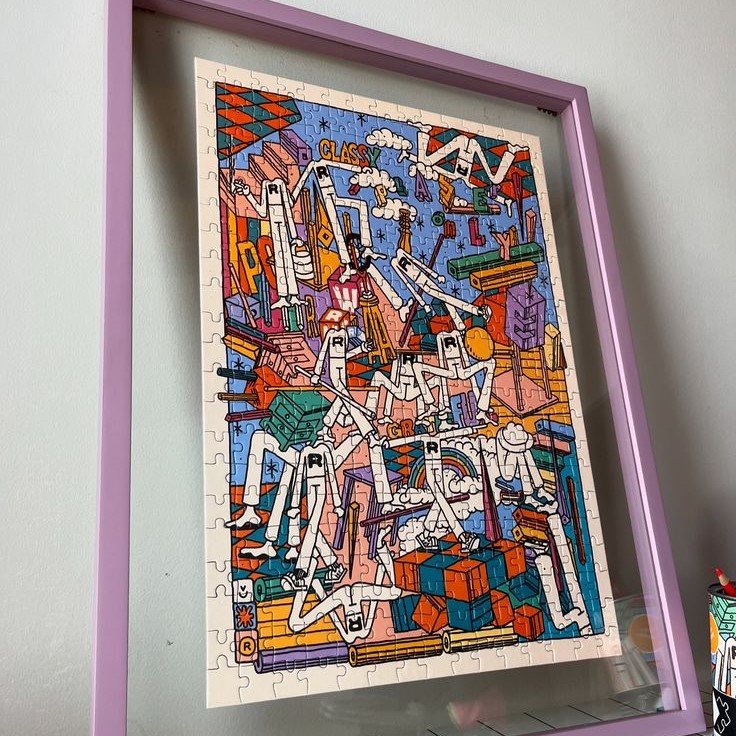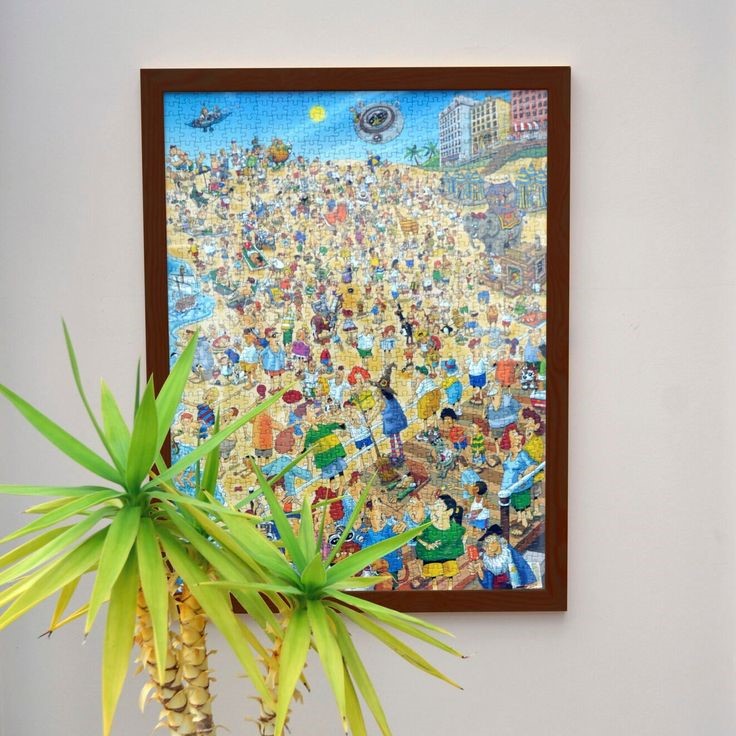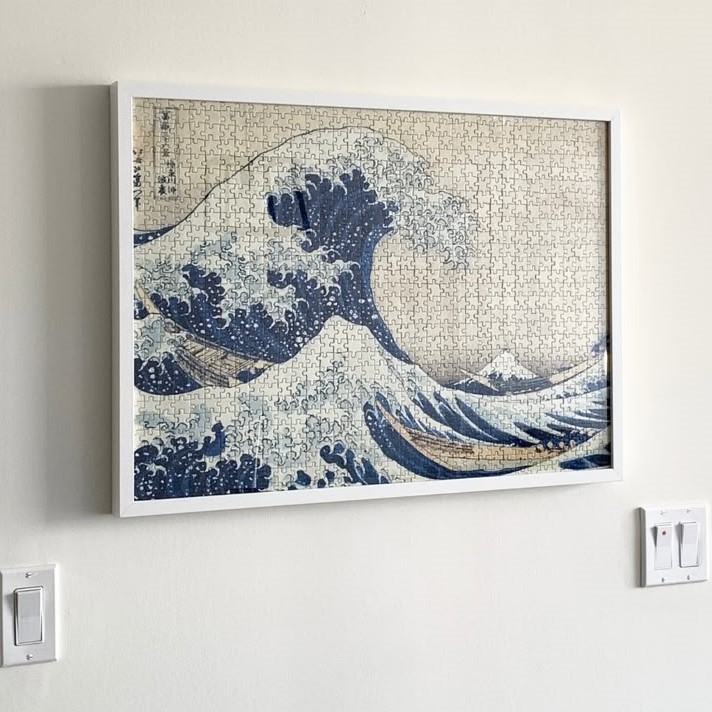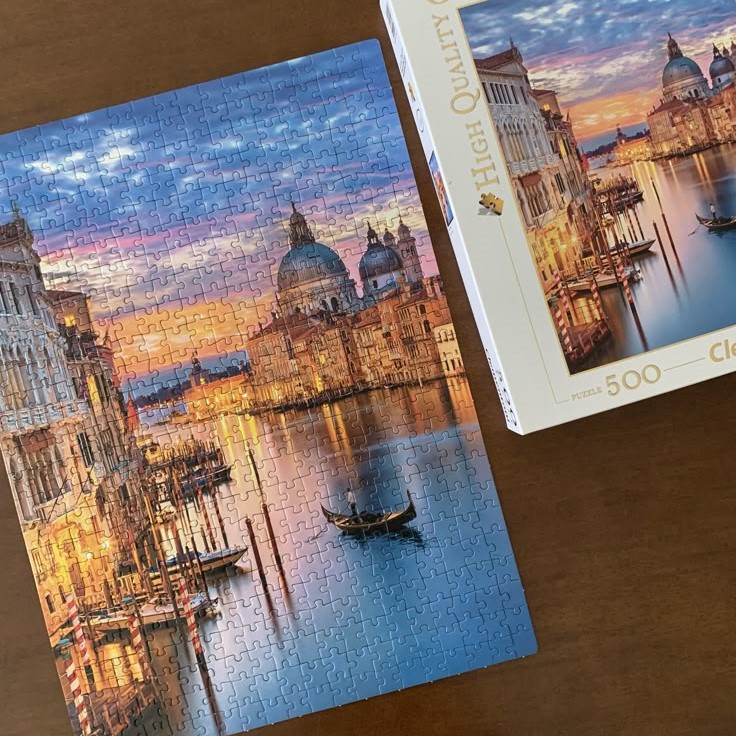Introduction: Why Learn How to Hang Puzzles?
If you’ve ever wondered “how to hang puzzles,” this guide is here to help. Completing a jigsaw puzzle is an accomplishment worth celebrating. But why stop there? By learning how to hang puzzles, you can turn these masterpieces into beautiful wall decor. Not only does it add personality to your space, but it also preserves the hard work you put into solving each piece. Whether you’re a seasoned puzzler or just starting out, mastering this skill opens up endless possibilities for showcasing your creations. Let’s dive in and explore step-by-step methods to achieve professional results.
Choosing the Right Puzzle to Hang
When thinking about how to hang puzzles, the first step is choosing the right one. Not every puzzle is suitable for display. Here are some tips to help you pick the perfect puzzle:

- Consider the Image: Choose a puzzle with an image that you love. It should complement the room’s decor where you plan to hang it.
- Check the Size: Make sure the puzzle fits the available wall space. Measure the area before you buy.
- Examine the Quality: High-quality puzzles with thick pieces are best for hanging. They last longer and look better on your wall.
- Think About Colors: The puzzle’s colors should match or accentuate the room’s color scheme. Bold colors can make a statement, while subtle tones can blend in.
- Personal Connection: If the puzzle has sentimental value or marks a special occasion, it’s a great choice for display.
- Level of Difficulty: Complex puzzles can offer a sense of achievement. Simple puzzles might be better for beginners.
Choosing the right puzzle is essential for an attractive and meaningful display. Always remember that the puzzle you pick will become part of your home’s aesthetic, so take your time in making the perfect choice.
Preparing the Puzzle for Framing
After choosing your puzzle, preparing it for framing is the next critical step. Proper preparation ensures your puzzle looks great and lasts long. Here’s how to prepare your puzzle:
- Complete the Puzzle: Lay out a puzzle mat or a clean, flat surface to complete your puzzle without interruption.
- Secure the Pieces: Once assembled, use a puzzle preserver glue to secure the pieces. Apply it evenly to avoid bumps.
- Let it Dry: Allow the glue to dry completely. The drying time may vary, so check the glue instructions.
- Trim the Edges: If there’s excess glue around the edges, carefully trim it off for a clean look.
- Attach a Backing Board: For additional support, attach your puzzle to a foam or backing board. This stabilizes your puzzle and prevents future warping.
- Frame Fit Check: Before framing, ensure your puzzle fits easily into the chosen frame. Make adjustments if needed.
By following these steps, your puzzle will be ready and well-preserved for the framing process. Remember to handle your puzzle with care to maintain its quality and appearance. Understanding how to hang puzzles starts with good preparation, setting the stage for a stunning display.
Selecting the Perfect Frame
Once your puzzle is ready, picking the right frame is key to enhancing its appearance. A great frame not only showcases your puzzle but also protects it. Consider these factors when selecting the perfect frame:
- Match the Style: The frame should complement both the puzzle and the room’s decor. Choose a style that fits well with both.
- Consider the Material: Frames come in various materials like wood, metal, or plastic. Opt for one that suits the weight and look of your puzzle.
- Size Appropriately: The frame must fit your puzzle precisely; too tight, and it might warp; too loose, and it’ll look sloppy.
- Look for Quality: A durable frame will better protect your puzzle over time. Don’t skimp on quality for such a prized display.
- Think About Glass: Choose between acrylic or glass covers. Acrylic is lighter and shatter-resistant; glass offers a clearer view.
- Consider Special Features: Some frames offer UV-resistant glazing that can prevent color fading due to sunlight exposure.
- Budget Wisely: It’s possible to find a suitable frame without overspending. Determine your budget and stick to it while shopping.
- Check for Hanging Hardware: Ensure the frame includes the necessary hardware for hanging. It’ll make the mounting process easier.
Selecting the right frame is a critical step in how to hang puzzles. It is where your preparation pays off, turning your puzzle into an artwork. Take your time and choose wisely to ensure your puzzle becomes a highlighted piece in your space.

Mounting Your Puzzle Securely
To successfully hang puzzles on your wall, secure mounting is crucial. Here’s a step-by-step guide:
- Choose the Right Adhesive: Select an adhesive that won’t damage the puzzle or wall. Removable double-sided tape works well for lighter puzzles.
- Measure the Space: Before mounting, use a tape measure to confirm the space on the wall fits the puzzle’s dimensions.
- Mark the Wall: Lightly mark where the puzzle’s corners will go. This ensures straight alignment.
- Place Mounting Strips: Apply mounting strips on the back of the puzzle. Attach more at the top than the bottom for better weight distribution.
- Secure the Puzzle: Once in position, press firmly on the puzzle for a few seconds to secure the adhesive to the wall.
- Check for Sturdiness: Gently tug on the puzzle to test its hold. If it feels loose, add more mounting strips.
By this method, your puzzle stays put and looks great on any wall. Remember, how to hang puzzles with care makes all the difference.
Hanging Techniques and Wall Considerations
Once you’ve framed your puzzle, the next step is to hang it. Here are some insights into that:
- Wall Type: Identify your wall type. Drywall, plaster, and brick require different hanging methods.
- Weight Distribution: Heavier puzzles need secure hooks or nails. Lighter ones may hang with adhesive strips.
- Avoid Direct Sunlight: UV rays can fade your puzzle. Hang it away from direct sunlight to preserve colors.
- Use a Level: Ensure your puzzle hangs straight. A level helps you achieve perfect alignment.
- Find the Studs: For heavier frames, locate wall studs to anchor the weight securely.
- Dry Fit: Before making any holes, hold your puzzle against the wall to finalize placement.
- Pencil Marks: Use a pencil to mark where you will place the hooks or nails. It’s a guide for precise mounting.
- Spacing: If hanging multiple puzzles, keep them spaced evenly. This enhances visual appeal.
By giving proper thought to these factors, your puzzle display will not only look professional but also stay secure over time. Remember to step back and review your work to ensure everything appears as you intended. Knowing [how to hang puzzles] involves more than just preparation; it’s about thoughtful execution.
Expert Tips for Aligning and Leveling
Getting your puzzle perfectly straight on the wall can be tricky. Here are some expert tips for aligning and leveling that make the process easier:
- Use a Laser Level: A laser level helps project a straight line onto the wall. Align the top of your frame with this line.
- Apply Painter’s Tape: Create a guideline with painter’s tape on the wall. It’s easy to remove and won’t leave a mark.
- Hang Temporarily with Push Pins: Before finalizing, use push pins to hang your puzzle. Adjust as needed to ensure it’s leveled.
- Measure from the Ceiling: Use the ceiling as a reference point. Measure down to where the top of your puzzle should be.
- Check Diagonals for Square: Measure from corner to corner. If the measurements are equal, your puzzle is square on the wall.
- Employ a Bubble Level: Traditional bubble levels work well too. Place it on top of the frame and adjust until the bubble is centered.
- Mark with A Pencil: Once leveled, make light pencil marks on the wall. These are your indicators for where to place hooks or nails.
By using these simple yet effective tools and techniques, you’ll have your puzzle hanging straight and secure in no time. Remember, patience is key—take your time to get it right.

Maintaining and Cleaning Your Puzzle Display
To keep your puzzle looking sharp and pristine, regular maintenance and cleaning are necessary. Here’s how to care for your puzzle display:
Dust Regularly:
Make it a routine to dust your puzzle display regularly to keep it looking its best.
Use a soft cloth or a duster to gently remove dust particles from the surface without scratching or damaging it.
Avoid using harsh cleaning tools, such as rough sponges or stiff brushes, as they can harm the delicate materials of the puzzle and its frame.
Use the Right Cleaner:
When it comes to cleaning glass or acrylic surfaces of your puzzle, ensure you use a cleaner specifically formulated for those materials.
Check the labels of the cleaning products to confirm they are safe for use on glass or acrylic to avoid any potential damage or discoloration.
Opting for a suitable cleaner helps maintain clarity and shine while preserving the integrity of the materials.
Light Cleaning:
For the best results, apply the cleaner to a soft cloth first rather than spraying it directly onto the surface.
This prevents excess cleaner from seeping into the edges of the puzzle and causing damage.
Gently wipe the surface using circular motions to ensure a thorough yet delicate cleaning process.
Avoid Water:
It is essential to avoid using water, especially near the edges of the puzzle.
Water can seep in between the pieces or into the frame, leading to potential swelling or other types of damage.
Instead, stick to dry cleaning methods or use a small amount of cleaner that is appropriate for the materials involved.
Check for Signs of Wear:
Periodically inspect your puzzle carefully for any signs of wear, such as fading colors, peeling, or deterioration of the materials.
Early detection of any issues allows you to address them promptly, preserving the beauty and quality of your puzzle.
Regular checks can help maintain the overall aesthetic and structural integrity of the display.
Handle with Care:
When cleaning the frame or glass, always handle your puzzle with care to prevent any shifts or falls that could cause damage.
Use both hands to support the frame adequately, ensuring stability while you clean.
Taking your time and being gentle during this process helps avoid accidents.
Rotate Displays:
If you have multiple puzzles, consider rotating them regularly to reduce their exposure to sunlight and dust.
This practice minimizes the risk of fading due to prolonged sunlight exposure and keeps all your puzzles in good condition.
Additionally, rotating your displays can refresh the look of your space and allow you to enjoy different puzzles throughout the year.

Keep it Cool:
Be mindful of where you hang or display your puzzle, avoiding areas near heat sources such as radiators, heaters, or direct sunlight.
Heat can cause materials to expand or warp, compromising the integrity of both the frame and the puzzle itself.
Instead, choose a cool, stable environment that safeguards your puzzles from temperature fluctuations.
Maintaining and cleaning your puzzle display properly ensures that your puzzle stays vibrant and intact for years. Regular care is an important part of [how to hang puzzles] successfully.
Creative Display Ideas Beyond Traditional Framing
Going beyond the standard frame can add personality and style to your puzzle art. Explore the following creative ideas:
- String and Clips: Use string and small clips to hang your puzzle like a clothesline. It’s simple and adjustable.
- Magnetic Display: Attach a thin metal sheet to your wall and use magnets to hold the puzzle in place. Swap puzzles easily!
- Decoupage Method: Apply your puzzle to furniture like tabletops using the decoupage technique for a unique look.
- Floating Shelves: Place your puzzle on a floating shelf. This works well for 3D or layered puzzles.
- Puzzle Collage: Create a wall collage with multiple puzzles. Frameless designs can showcase the art seamlessly.
- Window Art: If your puzzle is translucent, consider using it as a window display for a stained glass effect.
- Room Divider: Hang a large puzzle in a frame without back support as a room divider that displays its beauty from both sides.
- Ceiling Hang: Attach your puzzle to the ceiling! Especially captivating with intricate designs or glow-in-the-dark pieces.
Remember, how to hang puzzles isn’t just about practicality. It’s about creativity too. Have fun experimenting with different display methods!

Conclusion: Transform Your Space with Professional Puzzle Displays
In summary, knowing how to hang puzzles empowers you to enhance interiors uniquely. From choosing appropriate materials to implementing secure hanging techniques, every decision impacts final outcomes. Remember, practice makes perfect—don’t hesitate to experiment until desired appearances align perfectly. With dedication and creativity, even novice crafters can produce gallery-worthy results. So gather supplies and let inspiration guide you toward crafting unforgettable memories captured forever on walls.




